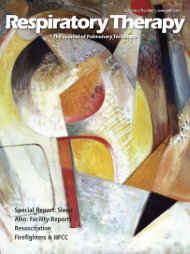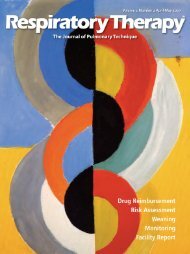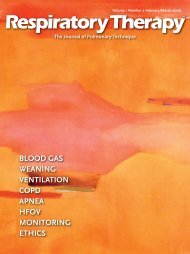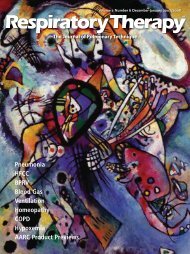RT 02-03 JJ07 main web - Respiratory Therapy Website
RT 02-03 JJ07 main web - Respiratory Therapy Website
RT 02-03 JJ07 main web - Respiratory Therapy Website
You also want an ePaper? Increase the reach of your titles
YUMPU automatically turns print PDFs into web optimized ePapers that Google loves.
Table 3 - Estimate delivered flow rate (LPM) for each patient<br />
4 Adjust PIP and rate for patient’s needs (Figure E).<br />
5 Verify PIP with a manometer.<br />
Methods of Evaluation<br />
The E-Vent Case manifold system is connected to a compressed<br />
air source using the twenty foot (20’) oxygen hose supplied.<br />
This bench top evaluation was conducted using the following<br />
two (2) scenarios:<br />
• When the gas source supplied is capable of <strong>main</strong>taining a<br />
constant 50 PSIG pressure to the manifold<br />
• When the gas pressure supplied is limited to maximum of 50<br />
PSIG<br />
In each scenario, i and ii, the VAR is operated in both the [A]<br />
100% FiO 2 mode and in the [B] 50% entraining mode to simulate<br />
oxygen consumption. In both cases, compressed air (21% FiO 2)<br />
is used and flow rate is measured. The density of the oxygen<br />
compared to the density of room air makes an insignificant<br />
difference in the flow measurements herein. At each pressure<br />
setting, flow from each individual VAR is recorded and<br />
summarized in Tables A1, B1, A2 and B2.<br />
Table A1 indicated the maximum flow of 291 LPM when<br />
operating 7 VARs in 100% mode. This requires the source<br />
pressure to be at 73 PSIG in order to <strong>main</strong>tain a 50 PSIG<br />
manifold pressure. Although this is not common, due to<br />
regulated hospital source gas pressure, it demonstrated that the<br />
manifold can deliver maximum flow to 7 VARs. Table B1<br />
indicated the flow demand is significantly less when operating<br />
in entrainment mode.<br />
When the supplied source pressure is regulated to 50 PSIG,<br />
adding or removing VARs to the manifold will result in a<br />
pressure drop as indicated in Table A2. When operating all 7<br />
VARs from a 50 PSIG gas source, the maximum flow available to<br />
each VAR will be 30 LPM. The pressure drop in the entrainment<br />
mode as shown in Table B2 is significantly less with a lower<br />
flow demand and maximum flow can be delivered for up to 7<br />
VARs.<br />
Conclusions<br />
The E-Vent Case manifold system demonstrated that it can<br />
sustain up to 7 VARs operating simultaneously. The key is to<br />
understand the supply pressure capability of the gas source<br />
(compressed air or oxygen). It is critical for each facility to<br />
evaluate the gas supply system in order to prepare for any surge<br />
1, 2, 3<br />
capacity incidents.<br />
Delivered Set manifold pressure<br />
flow 100% FiO2 50% FiO2<br />
20 LPM 25 PSIG 10 PSIG<br />
25 30 20<br />
30 40 30<br />
35 45 40<br />
40 50 50<br />
When connected, all patients on the same manifold system will<br />
receive the same amount of flow (LPM) regardless of their<br />
individual clinical situation. Any adjustment made on supply<br />
pressure will affect all patients connected to the manifold and<br />
flow is estimated to be within ±15% (see Table 3).<br />
*Health Resources and Services Administration (HRSA). HRSA<br />
works to fill in the health care gaps for people who live outside<br />
the economic and medical <strong>main</strong>stream. The agency uses its $7.4<br />
billion annual budget (FY 2005) to expand access to quality<br />
health care for all Americans through an array of grants to state<br />
and local governments, health care providers and health<br />
professions training programs. HRSA’S Special Programs Bureau<br />
provides $660 million in programs and services.<br />
References<br />
1 Donald G. McNeil Jr., Hospitals Short on Ventilators if Bird<br />
Flu Hits, New York Times, March 12, 2006.<br />
2 Dan Hanfling, MD, Equipment, Supplies, and<br />
Pharmaceuticals: How Much Might It Cost to Achieve Basic<br />
Surge Capacity? Acad Emerg Med Volume 13, Number 11<br />
1232-1237, published online before print June 26, 2006.<br />
3 Frederick M. Burkle, Jr., MD, MPH, Population-based Triage<br />
Management in Response to Surge-capacity Requirements<br />
during a Large-scale Bioevent Disaster. Acad Emerg Med<br />
Volume 13, Number 11 1118-1129, published online before<br />
print October 2, 2006.<br />
<strong>Respiratory</strong> <strong>Therapy</strong> Vol. 2 No. 3 � June-July 2007 37











